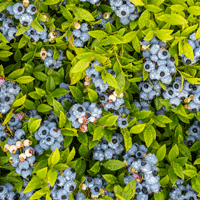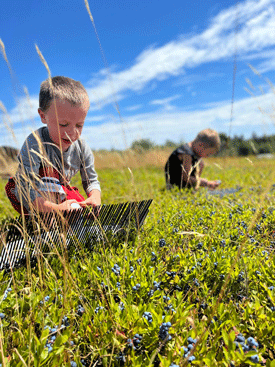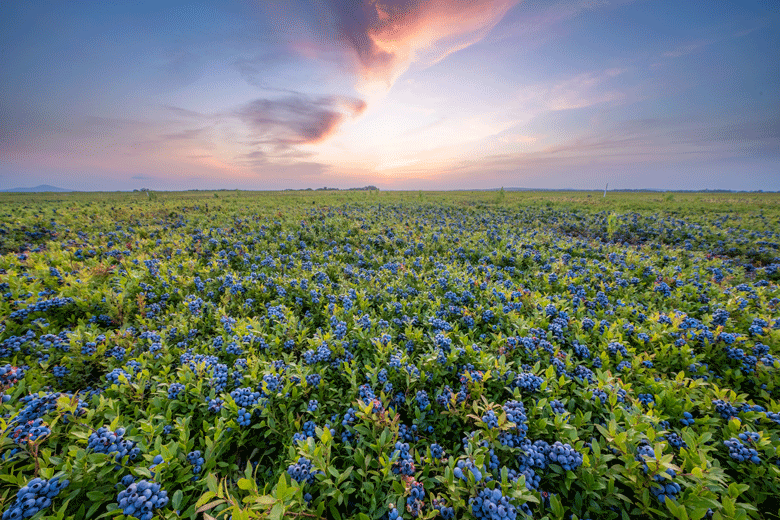When Lisa Hanscom leads tours of Welch Farm, she showcases a working wild blueberry farm, and a slice of her family history, too. Hanscom’s grandparents purchased the Roque Bluffs farm in 1912, moved in after their wedding on Christmas Day, and over time, her grandfather converted the fields to wild blueberries.
Today, four generations of the family still bring in the harvest from seaside barrens overlooking Englishman’s Bay.
Hanscom’s lengthy family relationship with the blueberry is overshadowed only by the incredible 10,000-year story of the wild blueberry itself, and that, she says, is what captures visitors’ imaginations. After their tour, Welch Farm visitors filter in and out of a red barn, leaving with jams, jellies, and a better idea of what those iconic little berries mean to Maine.
“Wild blueberries are native to North America, and in any given field, there are going to be 1,000 different varieties.”
“Wild blueberries are native to North America, and in any given field, there are going to be 1,000 different varieties. They all look different, and they all taste different, and they’re all planted by Mother Nature, not us,” says Hanscom.
They also add about $250 million to Maine’s economy each year.
“Part of our mission here at Welch Farm is to educate people about the wild blueberry,” Hanscom says. “If I have to do it one person at a time, I will.”

Hanscom isn’t alone in her mission to educate people about the wild blueberry. In fact, it’s a songbook the entire industry is singing from, spreading the word that wild blueberries are different from their farmed counterparts—containing twice the antioxidants, 70% more fiber, and higher concentrations of anthocyanins that can support eye, heart, and brain health.
Then there’s the undeniably romantic appeal of a plant that followed receding glaciers onto the sandy soils of eastern Maine, creating millennia-old barrens that glimmer purple in August, then flaming red in autumn.
These are just a few of many things, say Maine blueberry farmers, that make the wild blueberry far from ordinary.
“From an industry perspective we need to continue to decouple the wild blueberry from the cultivated blueberry. Consumers often don’t understand the differences between them,” says Colleen Craig of Wyman’s, another Downeast business with deep roots in blueberries—the Milbridge-based grower and processor is preparing to celebrate its 150th anniversary next year.
Wyman’s is the largest branded supplier of wild blueberries in America, selling its distinctive blue bags into grocery store freezers across all 50 states. Recently, Wyman’s added a line of frozen fruit cups, and shelf-stable products like wild blueberry juice and dried blueberry powder.
“Our mission is to help people eat more fruit. According to the USDA Dietary Guidelines from 2020-2025, eight out of ten Americans are not getting the recommended daily amount,” says Craig. “We’re committed to innovation within the industry and developing fruit-forward products.”
VALUE ADDED
In business speak, converting a basic product like a wild blueberry into something like blueberry juice is known as “adding value.” Some farms are taking other paths to increase their profitability. One of Maine’s largest growers, Passamaquoddy Berries, which manages 2,000 acres of wild blueberry barrens, cushions volatile field prices by selling some berries under its own brand. Hanscom has diversified her farm’s business with the addition of two rental cabins, and plans to begin hosting weddings next year.
Eric Venturini, executive director of the Maine Wild Blueberry Commission, says there is growing excitement for value-added wild blueberries, both in the industry and among consumers.
“There are a lot of opportunities for producers to diversify their offerings, increase the cash flow to their business, and have a more consistent income and stability,” Venturini says.

Consistent income and stability can be hard to come by in agriculture, and wild blueberries are no exception. Significant price drops over the last decade hit a low in 2017, when the average price to growers was 26 cents per pound. Since then that number has rebounded and last year hit 72 cents per pound, and there are other positive indicators.
Over the last five years, frozen wild blueberry sales at retail have increased 88%. But as in the rest of the U.S. economy, wild blueberry farmers are facing rising costs and labor shortages.
The industry is keeping its eye on other challenges too, like the potential impacts of climate change, including droughts like the ones that impacted Maine growers for several years before this year’s plentiful rainfall turned that tide.
“We are working very hard to free up financial and technical support to help people become more resilient to climate change through sustainable water resource development and irrigation,” says Venturini.
Blueberry research is one of three major focus areas for the Wild Blueberry Commission, alongside promotion and policy work, and they are not alone. In her work as wild blueberry specialist with the University of Maine Cooperative Extension and School of Food and Agriculture, Dr. Lily Calderwood connects farmers with research conducted by UMaine and vice versa.
Recently, Calderwood’s group completed a two-year study on the use of mulch to help retain moisture on the fast-draining, sandy soils where wild blueberries grow. The good news is it helps.
“These drought years have been so severe that mulch alone will not solve the problem most likely, but it can buffer the problem. Some fields will still need irrigation,” says Calderwood.
Abbie Sennett and husband Jacob Lennon relied on their irrigation system during the drought in 2022. Now in their 20s, the pair met as young teenagers working on Abbie’s family farm in Albion, perhaps even more well-known for bees than for blueberries. Abbie’s father, Lincoln Sennet, is the founder of Swan’s honey, a famous Maine brand.
After harvesting their berries from barrens in Machias, each day Abbie and Jacob transport them back to Albion, where they have easy access to labor for processing.
“The biggest challenge we face is labor shortages,” says Abbie. “A month-long job isn’t enticing to most people.”
At their young age, and with their willingness to assume leadership roles in the industry, Venturini says Abbie and Jacob represent a positive direction for Maine’s wild blueberry industry.
As of two years ago, the average age of a Maine wild blueberry farmer was 64.5 years old.
“I’m very hopeful that will continue,” says Venturini of the younger folks, “and we can help prepare a new cohort of wild blueberry farmers to step into the industry and continue this tremendous tradition that’s really part of the cultural underpinning and part of Maine’s heritage.”
Like many Mainers, Abbie has fond childhood memories of blueberry season, and says she misses the days of hand raking. But she’s also fond of wild blueberry farming, today.
“There’s something about the Downeast area when everyone goes for the harvest, the tourists want to see the fields and buy blueberries, I think it’s special,” she says. “What’s more Maine than wild blueberries? There’s not much.”





